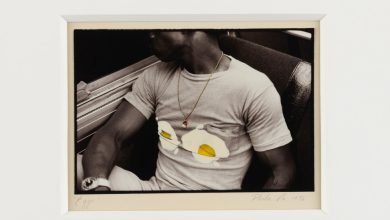Pippa Garner’s Wild Ride

High-heeled roller skates, a palm-frond umbrella and a shower in a can — these are just a few of Pippa Garner’s hundreds of inventions. For the past 50 years, the artist has been satirizing U.S. consumer habits with designs that are not always entirely useful. Few things have escaped her restless, imaginative tinkering, from automobiles to her own body, which she began, in her words, “gender-hacking” in the mid-1980s. That may be why the art world establishment long treated Garner, 81, as a fringe character, more madcap inventor than conceptual artist in the tradition of Marcel Duchamp or Andy Warhol.
But this year, things seem poised to change for Garner, who debuted her first U.S. solo museum show at Art Omi, the international arts organization in Columbia County, N.Y., on June 24. The exhibition includes a recreation of her 1974 sculpture and performance “Backwards Car,” for which Garner lifted and flipped the chassis of a ’59 Chevy so that, when she drove it across the Golden Gate Bridge, it appeared to be traveling in the wrong direction. There are meticulous pencil and ink drawings of unrealized inventions whose formats lampoon magazine advertisements. (Some of her most ambitious works were commissioned by actual publications, such as Esquire and Rolling Stone.) There are T-shirts printed with Garner’s sardonic proto-meme images and slogans, including one featuring the actor Nick Nolte and the words “I pay my stalker a living wage” in all caps. These hang alongside the suit with a cropped, navel-baring blazer that Garner wore for a 1982 appearance on “The Tonight Show Starring Johnny Carson,” shortly before she began her gender transition.
In the fall, Garner’s work will also be featured in the Made in L.A. biennial at the Hammer Museum, not far from her home in Los Angeles. (For many years, she could be seen traversing the neighborhood in one of several four-wheeled pedal vehicles she designed and built.) The biennial, which will coincide with the U.S. leg of a touring career-survey exhibition at New York’s White Columns galleryand the publication of a monograph in October, will seek to reframe Garner as an important parallel and associate to other West Coast artists who critiqued the consumerism, mass media and car culture of the postwar era, such as Ed Ruscha, Chris Burden and Ant Farm.
Garner was born in Naperville, Ill., in 1942 and recalls feeling detached from the normative culture of suburbia at an early age. After her father — who sold magazine advertisements to car companies — moved the family to Grosse Pointe, just outside of Detroit, in the late 1950s, he encouraged his artistic child to apply her creativity to automotive design. She was most excited by what she describes as the anthropomorphic quality of cars, an animism she still attributes to various consumer goods. “Cars from that era all had really distinct faces, with headlights as the eyes,” she says. “The Buick had a tooth grill that looked like a big sneer. The Seneca had a sort of rocket nose.” In 1969, while a student at ArtCenter College of Design in Los Angeles, she created the sculpture “Kar-Mann (Half-Human, Half-Car),” a small replica of a Volkswagen Karmann Ghia with two humanlike hind legs modeled from fiberglass. The school, she believes, misinterpreted the work as a joke and she was expelled. Rather than reverse course, Garner concluded that her teachers — and most other people, really — took themselves much too seriously.
Garner’s biggest projects over the next two decades involved disused or reconfigured automobiles. In 1976, West magazine commissioned her to construct a facsimile home from junked car parts, replete with a hood roof and chrome windows made of fenders. Her 1986 sculpture “Long Time No Sea” embedded the cockpit of a speedboat in the roof of a ’68 Buick LeSabre, producing what she called the world’s first ever “Nauti-Mobile.” These projects were produced in tandem with Garner’s altered household appliances (like the “Escaladder,” 1982,an escalator step ladder) at a time when a nascent environmental movement brought new attention to the ecological consequences of car culture and mass consumption. “Pippa likes this idea that she saves these old consumer objects and reanimates them for a second life, because she was devastated by planned obsolescence,” says Fiona Alison Duncan, a co-curator of Garner’s touring exhibition and the author of the forthcoming monograph. Such works are early, imaginative efforts to reuse and recycle at an industrial scale.
Garner’s resistance to the gender binary was similarly ahead of its time. “I thought, with all this energy that I was putting into altering consumer appliances from the assembly line, can’t that be adapted to the human body?” she says. “If I can work with a waffle iron, why not the body? I already have one, and it’s for me to decide what I want to do with it, if I want to have fun with it and play with it.” In the mid-1980s, Garner obtained black-market estrogen with help from trans sex workers she met on Hollywood Boulevard, and in 1991 underwent top surgery, though she continued living as a man for two more years. A striking photo from this era opens “Post-Human,” a 1992 exhibition catalogby the curator and art dealer Jeffrey Deitch: In it, Garner dons a pinstripe suit with cutouts revealing her new breasts (or “tits,” as she prefers to call them), and stares back at the camera with a sly grin.
For Garner, the new attention from the art world can’t come a moment too soon. Last year, she was diagnosed with leukemia, which she attributes to contamination from Agent Orange during a short stint with the U.S. Army in Vietnam. While she isn’t pedaling around Los Angeles as often anymore, she’s eager to see how her work will be received by a younger generation. Duncan believes they have much to learn from her. “Pippa’s like a proto-millennial freelancer,” she says. “She lived on the edge in the way that almost a whole generation now does. But she also shows that you can have a lot of joy within a very simple, humble life — while facing a lot of adversity, andwithout shying away from the devastations of America — by living with a lot of grace and humor.”





